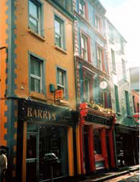
Culture abounds in Cork as evidenced by the city being named 'Europe's Capital of Culture' for 2005. This means that for 2005, Cork will be showcasing its cultural treasures and vibrant artistic scene to the world through various events. Some of the city's notable cultural attractions include the Cork Public Museum, Crawford Municipal Art Gallery, St. Anne's Church, the Cork City Jail, and the National Radio Museum. The Cork Public Museum highlights the city's role in the struggle for Irish independence while the art gallery features the work of Irish artists with its permanent collection including Jack Yeats and Sean Keating. St. Anne's dominates the northern part of the city and contains a collection of 17th century Bibles as well as letters written by the poet John Donne.
Today one of the annual attractions that draws the most interest is the city's jazz festival, which typically takes place in October. The jazz festival highlights Cork's attitude toward the arts and general bohemian spirit. This is arguably the modern expression of the city's traditional rebelliousness, which first manifested itself when Cork served as the base for the National Fenian movement.
Geography is another aspect of Cork that makes it unique. Cork's city center is actually an island, situated between two channels of the river Lee. With a population of approximately 123,000, Cork is the Republic of Ireland's second largest city behind Dublin, which has a population of over 1 million. The entire Republic of Ireland has a total population of approximately 3.9 million. The geography of the city also gave it its name, which is derived from the Irish word, corcaigh, a term which referred to the marshes that the city was built on and between. The city's geography also influenced it through a strong maritime history with its deep natural harbor as one of its defining features.


